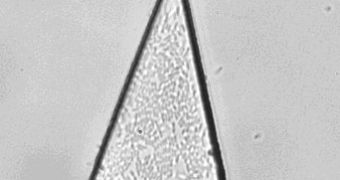A new discovery in the field of nanotechnology could produce the smallest "engines" in the world. The best part is that scientists will be able to remotely control them using rays of UV light that make a group of bacteria push the nanomachines both in straight line and on curved trajectories.
Researchers led by Min Jun Kim at Drexel University in Philadelphia developed a new propulsion system based on living organisms. They successfully experimented a method of "convincing" the bacteria to move tiny machines, with the length of several nanometers, in almost every direction.
Flagellated bacteria propel themselves using biomolecular motors and the new technique proved that they could be used as microscopic burden horses, to move nanoscale sheets of epoxy through a liquid.
All it takes to start, stop and direct the movement is UV light that can be switched on and off and can be either linear or rotational. The bacteria, Serratia marcescens, can be made to move tiny triangular sheets of epoxy very quickly until exposed to UB light, which makes them stop.
The bacteria were grown in a Petri dish filled with agar, a gel widely used for this purpose and then introduced at an edge of an epoxy triangle, where they started to multiply before starting to move across the surface of the plate in waves.
They can be made to move faster if a liquid layer of nutrients is added, in which the triangle rested on a leading edge of a bacterial wave moving across the agar surface.
Although the technique needs additional improvement, this ingenious biological engine could find many practical applications, like in micro- and nanoscale devices that could deliver drugs to a precise location in a human body, through the bloodstream, due to the precise and equally ingenious control technique.

 14 DAY TRIAL //
14 DAY TRIAL //